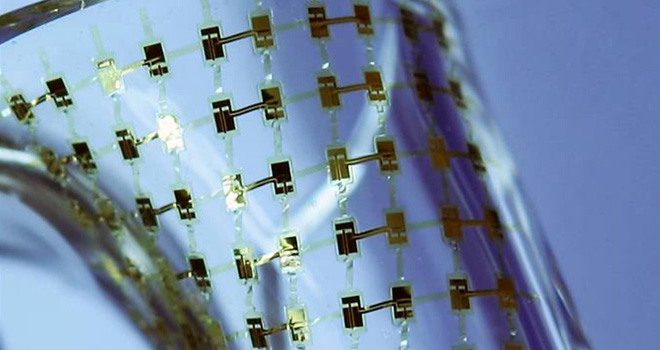After more than a decade of research and testing, electronics that can bend and stretch over virtually any surface are finally making their way to the marketplace.
One company in the space is mc10, a start-up in Cambridge Massachusetts. mc10 bases its products on research by co-founder and University of Illinois materials scientist John Rogers, and it’s developing a new class of semiconductor applications that broadly range from from catheters to clothes.
The company’s first commercially available product debut will come in the form of athletic apparel integrated with “skin like” high-performance electronics. It’s being created for Reebok, and will debut during the first half of 2012, says chief executive David Icke.
Neither mc10 nor Reebok have released details on the products, but rumors speculate shirts that can monitor a runner’s pulse or a hoodie that can charge an iPod.
While that sounds useful, Rogers says that the future of bendable electronics has far wider implications.
“The real leading edge in the research, and its societal importance, exists where we can address problems in human health,” he said.
“The most compelling opportunities are with the human body,” he told TPM. “But you can imagine other things, too. Great things.”
Rogers’ research has already made a splash in hospitals. His work has led to electronic sensors than can wrap around a balloon catheter to monitor vital stats during an angioplasty operation and a strip sensor that sticks to the heart’s outer tissue layer in order to monitor arrythmias.
Last month, Rogers was awarded this year’s $500,000 Lemelson-MIT prize for his work on “revolutionary products integral to human health, fiber optics, semiconductor manufacturing and solar power.”
mc10 is joined by other institutions working with bendable electronics, like Takao Someya at the University of Tokyo, and Stephanie Lacour at the Ecole Polytechnique Federale de Lausanne. Lacour worked with Nokia to make a prototype stretchable electronic sensor designed to wrap around prosthetic limbs.
mc10 CEO Icke says his company distinguishes itself from the others because it uses existing materials to create a new genre of circuit boards that can conform to surfaces as complex as the human brain.
“It’s the difference between being able to wrap around a [smooth surface] like a Coke can versus an apple,” he says.
It hasn’t always been smooth sailing. But after fourteen years of researching ultra-thin circuit chips, Rogers’ concept is finally gaining traction with investors.
Last month the company raised $12.5 million in its Series B-round of financing, winning over new investor Braemar Energy Ventures.
The company’s also supported by grants from government agencies including the Office of Naval Research and the Department of Energy, and funding from the Bill & Melinda Gates Foundation.
Rogers’ laboratory is also working to apply the technology to batteries, solar cells, and wireless equipment.
As MSNBC reports, his lab is working toward producing a new photovoltaic module binding together miniature solar cells (each the size of a grain of sand) and tiny glass lenses. The Tucson Electric Power Company is currently piloting the module.
Jaeah J. Lee is an editorial fellow at Mother Jones magazine in San Francisco. Previously she worked as a research associate at the Council on Foreign Relations. She has written in the Christian Science Monitor, Global Post, and Huffington Post.
Read her latest pieces here and follow her on Twitter.
Got a story idea or tip for Idea Lab? Send them to Idealab@talkingpointsmemo.com.






